North Korea’s digital isolation represents the most extreme case of internet censorship in existence today. This comprehensive system of technological restrictions creates a sealed information environment where citizens encounter only state-approved content. Through Kwangmyong, the country’s proprietary intranet, authorities implement multi-layered filtering and monitoring protocols that ensure strict compliance with government narratives. While most nations use digital infrastructure to connect their populations, North Korea’s digital isolation serves precisely the opposite purpose—creating technological barriers that prevent information exchange with the outside world.
This digital separation reflects not just the regime’s determination to control information flow but also reveals its fundamental fear of external influence. Let’s examine how this system affects privacy, information access, and North Korea’s relationship with the global digital community.
Watch this video for a quick insight: NORTH KOREA’S Bizarre Internet Rules.
The Foundation of North Korea’s Digital Isolation
Why Digital Isolation Exists
North Korea’s extreme digital separation isn’t accidental—it’s strategic. The regime has transformed internet technology from a tool of global connectivity into a mechanism for control and isolationism. Access to external information could empower citizens to question state narratives, directly threatening regime stability. Here’s how this control system operates:
- Preservation of State Ideology: The leadership prioritizes Juche—their philosophy of self-reliance and independence. External information, whether news or cultural content, threatens this carefully constructed worldview. By permitting only state-approved content, authorities ensure citizens internalize the official version of reality. Learn more about this approach here.
- Elimination of External Influence: Social platforms like Facebook, YouTube, and Twitter aren’t merely inaccessible—they’re illegal. These connectivity tools represent potential exposure to outside perspectives, so North Korea blocks all foreign websites, effectively closing any channel for unfiltered interaction with the world.
- Power Consolidation: The digital restrictions function as a protective firewall around the regime’s authority. By limiting internet access to carefully monitored elites, the government maintains control at every level of society.
In essence, North Korea has adapted its historical propaganda approach to the digital age, wielding internet technology as a tool for indoctrination rather than information exchange.
Kwangmyong: The State-Controlled Intranet
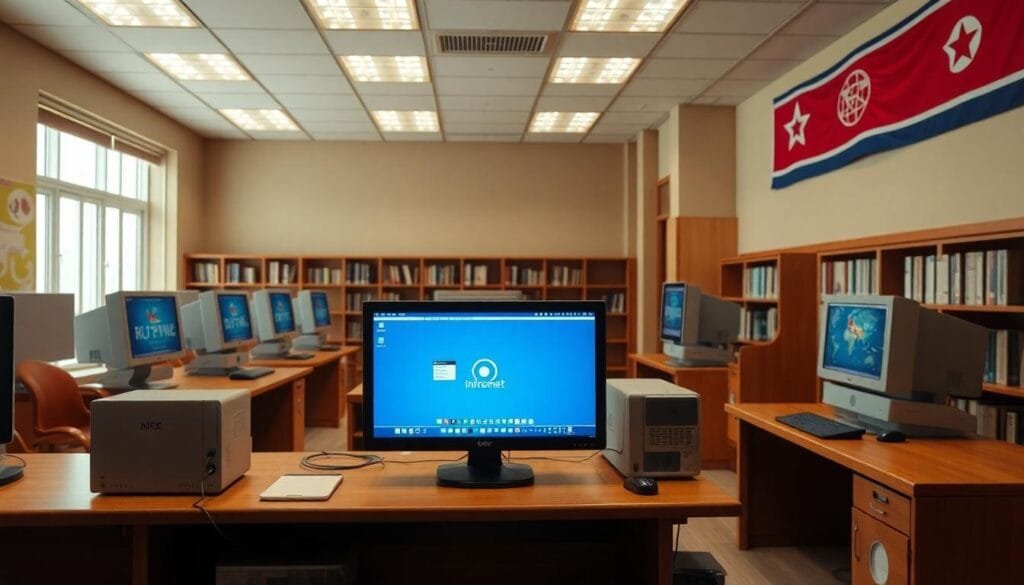
Imagine if your entire internet experience consisted of a limited encyclopedia filled with government propaganda—that’s Kwangmyong, North Korea’s national intranet. Unlike the global internet, this system operates as a closed circuit with no external connections. So how exactly does it work?
- Pre-Approved Content Only: Everything on Kwangmyong undergoes strict government vetting. Users can access domestic news, scientific information, and educational resources—all carefully filtered to reinforce state messaging. Okay, so imagine Wikipedia, but where every entry has been reviewed by someone whose job depends on making sure nothing contradicts the official narrative. You can read about its operation on Wikipedia.
- Limited Physical Access Points: Kwangmyong is primarily available on stationary computers in government buildings, libraries, and universities. Some citizens can access it via mobile devices, but the content remains entirely controlled. Students might access digital textbooks, but the information diversity we take for granted simply doesn’t exist.
- Functional Imitation Rather Than Replication: Kwangmyong isn’t designed to match the global internet’s capabilities. Instead, it superficially mimics internet functionality, providing just enough “digital literacy” to prevent citizen discontent. For a deeper analysis of its structure, visit North Korea Tech.
While this system may seem dystopian to outsiders, most North Koreans have no alternative reference point. The government walks a careful line—providing enough digital engagement to prevent unrest while maintaining sufficient isolation to block uncontrolled information flow.
Restricted Access to the Global Internet
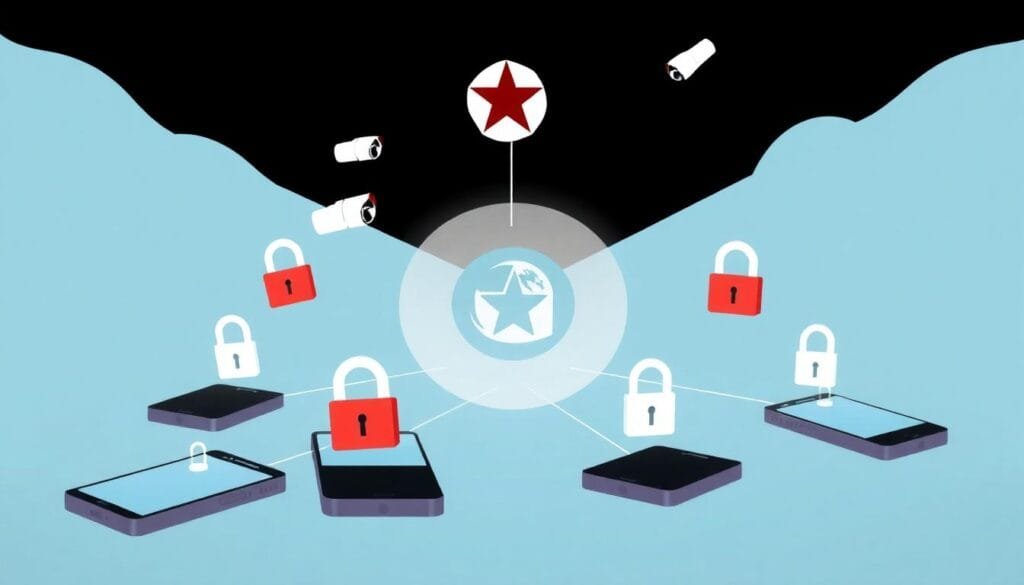
Mobile Networks Under Government Control
North Korea’s approach to mobile infrastructure represents its paradoxical relationship with technology: allow sufficient modernization to monitor citizens without granting them genuine autonomy. The country’s main network, Koryolink, established through international partnerships, offers a technically capable yet deliberately restricted service. Although classified as a 3G provider, domestic users can only access the intranet—a closed ecosystem designed specifically to control information flow. For a detailed history of this network, check Koryolink’s development timeline.
Mobile devices sold in North Korea come pre-installed with government-approved applications that enhance surveillance capabilities. For international visitors or diplomats, Koryolink presents unique challenges—no roaming agreements exist, and temporary access offers minimal connectivity. Despite technological advancements, mobile services remain firmly under state control.
While mobile phone ownership might suggest progress, this connectivity doesn’t represent freedom but instead serves as another surveillance channel. For a comprehensive analysis of North Korea’s mobile network evolution, see this report by 38 North.
Surveillance Infrastructure
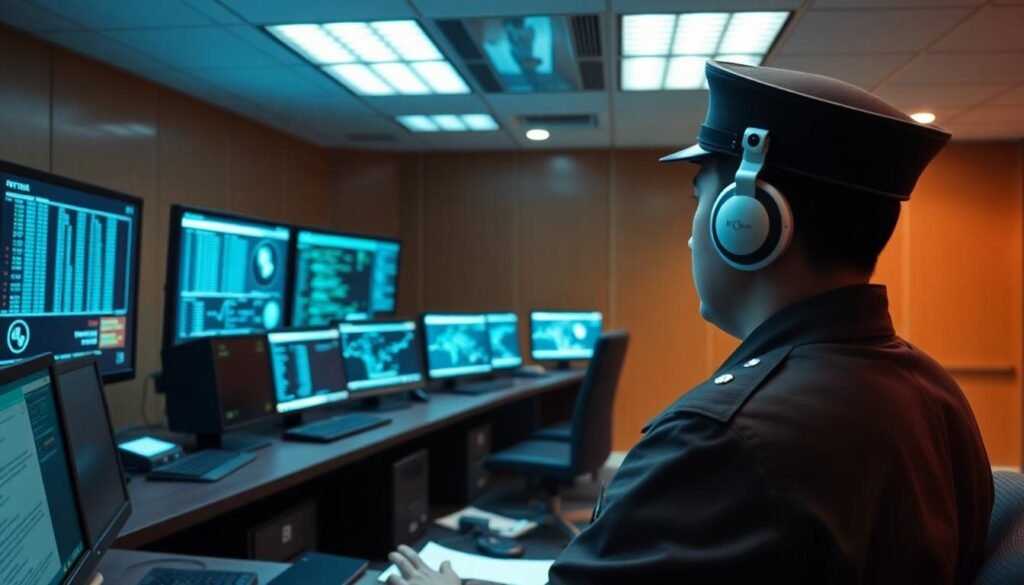
The privileged few with global internet access—primarily high-ranking officials and state researchers—experience anything but digital freedom. Their online activities undergo intense monitoring through surveillance systems that mirror North Korea’s physical monitoring apparatus. Authorities track browsing histories, email communications, and real-time activities through technology designed for comprehensive oversight.
Device monitoring extends beyond usage patterns. Mandatory surveillance applications track users’ locations, monitor installed files, and flag any foreign content. This surveillance isn’t merely passive—a downloaded file could trigger immediate reporting to authorities. For an in-depth examination of North Korea’s surveillance practices, see Amnesty International’s report.
The regime employs multiple surveillance methods to ensure compliance. Beyond technological monitoring, in-person observation is standard practice. Government monitors frequently sit alongside users in public facilities, approving each online activity in real-time. This system creates an environment reminiscent of Orwell’s “1984,” designed exclusively to maintain state control. For a detailed account of North Korean internet policies, read this Wired article on getting online behind North Korea’s digital wall.
Consequences of Digital Isolation
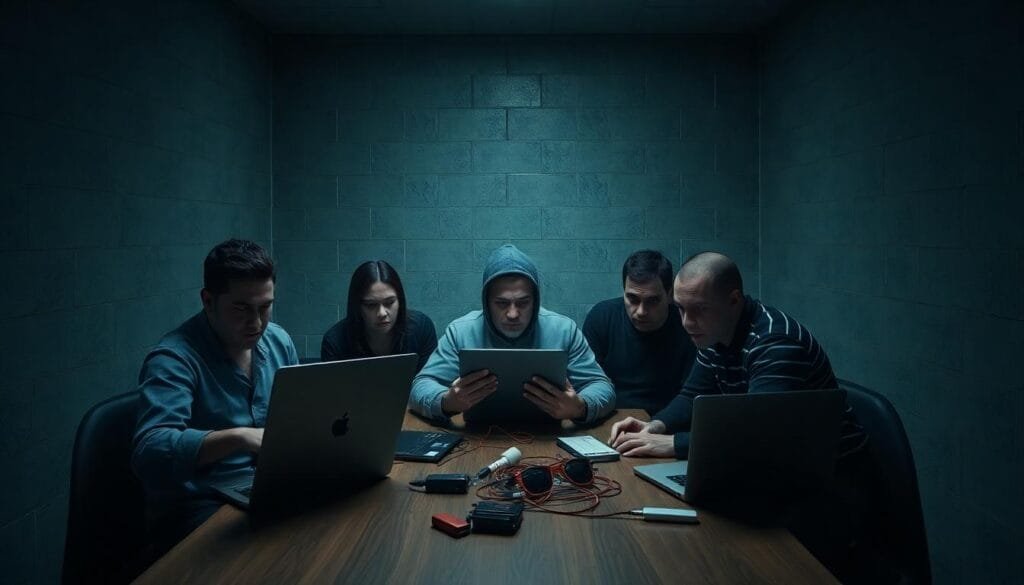
Severe Penalties for Unauthorized Access
In North Korea, attempting to bypass digital restrictions carries enormous risk. Citizens who access the global internet or use foreign networks face severe punishment. Whether through smuggled smartphones, illegal Chinese networks near borders, or VPN services, the consequences for circumvention are harsh and often life-changing.
- Extreme Punishment Systems: Those caught connecting to outside sources risk detention, forced labor camps, or worse. Being accused of accessing foreign media or contacting unapproved individuals can result in political prison camp sentences, as documented extensively by human rights organizations. According to the Committee for Human Rights in North Korea, these punishments have intensified under Kim Jong-un’s leadership. For more information on these penalties, see this analysis.
- Advanced Detection Methods: The North Korean government employs sophisticated technology to monitor citizens. Mobile devices require surveillance applications that track locations and automatically report suspicious activity. Near the Chinese border, specialized Bureau 27 agents use signal detection equipment to identify foreign connections. These detections frequently lead to immediate arrests.
- Contraband Media Crackdowns: The increasing prevalence of smuggled media—particularly South Korean content on USB drives—has intensified enforcement efforts. Not only are storage devices confiscated, but even accidental possession of foreign material can result in charges of “enemy collaboration.” For context on this enforcement campaign, read this comprehensive report.
These punitive measures illustrate the extreme lengths the regime will pursue to maintain digital isolation, further separating citizens from global information access. For North Koreans, accessing forbidden information could cost not only their freedom but potentially their lives.
Digital Divide Between Elites and General Population
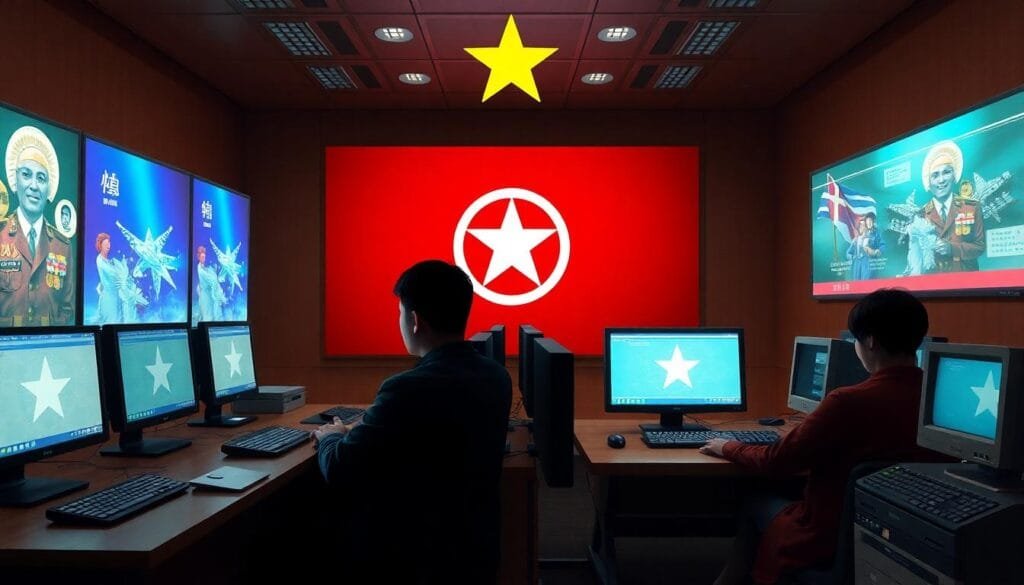
North Korea’s digital segregation affects different populations unequally. A stark division exists between how the elite minority and general population experience connectivity, amplifying existing social and economic disparities.
- Privileged Internet Access: A small elite group, including government officials, researchers, and cyber specialists, can access the global internet under strict monitoring conditions. These privileged users receive this access to maintain diplomatic connections or support state-sponsored cyber operations. Learn more about this exclusive arrangement here.
- Restricted Intranet for Most Citizens: The general population can only access Kwangmyong, the state-controlled intranet. This curated network offers educational materials, propaganda, and limited cultural content but remains completely isolated from external information. This division effectively creates two separate North Korean experiences—one minimally connected to global information and another entirely confined within state narratives. Explore this disparity further here.
- Geographic Connectivity Disparities: Those in rural or remote regions experience even greater digital isolation compared to citizens in wealthier areas like Pyongyang. In these regions, technological infrastructure is virtually nonexistent, further widening educational and economic opportunity gaps.
This elite-controlled internet access mirrors broader aspects of North Korean society, where centralized power determines who benefits and who remains isolated. The result isn’t simply a digital divide—it’s a fundamental separation that keeps most citizens within a state-controlled information bubble while allowing a privileged minority to navigate (and exploit) the digital world.
Technological Developments Under State Control
Red Star Operating System
North Korea’s domestically developed Red Star OS represents digital control taken to its logical extreme—an operating system designed primarily for surveillance rather than user empowerment. Developed by the Korea Computer Center, this Linux-based system appears outdated by global standards but serves a specific purpose: maintaining government oversight of all computer activity.
What makes Red Star OS so restrictive? First, it incorporates extensive surveillance capabilities. The system logs every user action, from application usage to file access. Any attempt to modify the operating system or install unauthorized software triggers immediate flagging. Foreign media possession can result in severe punishment, as the system constantly scans for and blocks unapproved content. Learn more about Red Star OS here.
Additionally, Red Star OS includes proprietary applications that mimic global equivalents like word processors or email clients but restrict users to North Korea’s domestic intranet. While the interface borrows design elements from macOS, the similarity is purely cosmetic.
Most significantly, the system employs encryption and watermarking tools that make files traceable to their origin, adding another layer of communication control. By isolating users completely from foreign influence, Red Star OS functions as a digital gatekeeper, protecting the regime’s information monopoly. Examine Red Star OS’s surveillance framework for a more detailed analysis.
International Technology Partnerships
While North Korea adamantly defends its sovereignty, it relies on strategic international partnerships to advance its technological capabilities. Countries like China and Russia have played crucial roles in developing North Korean internet and communications infrastructure, enabling controlled modernization according to Pyongyang’s requirements.
In telecommunications, Chinese and Russian companies provide essential expertise and technology since North Korea lacks independent capacity to develop advanced networks. Significant contributions include mobile network construction and maintenance. Companies such as Huawei have faced allegations of indirectly supporting North Korean infrastructure needs through intermediary supply chains.
During the early 2000s, a partnership with Egypt’s Orascom established Koryolink, North Korea’s first major mobile network. Though this relationship later deteriorated due to financial disputes, the initial technical contributions became fundamental to the country’s telecommunications infrastructure. Joint fiber-optic projects and data routing technologies highlight foreign firms’ ongoing involvement in the region. Read more about international collaborations driving North Korean technological advancement.
However, these partnerships involve significant complications. International entities must balance sanctions compliance with opportunities in North Korea’s isolated economy. Despite these challenges, Pyongyang strategically leverages these collaborations, absorbing external expertise while maintaining system isolation to prevent outside influence.
Through these international partnerships, North Korea gradually modernizes its digital infrastructure. Yet every technological component installed through international collaboration is calibrated to ensure the regime maintains absolute control over citizens’ digital activities.
Understanding the Reality of Digital Life in North Korea
North Korea’s approach to digital control represents perhaps the most extreme case of internet censorship globally. This system doesn’t just limit information—it fundamentally reshapes how citizens understand the world by creating an alternative digital reality entirely controlled by the state. The technical infrastructure, from the Red Star OS to the Kwangmyong intranet, forms an integrated system designed not for connectivity but for surveillance and isolation.
For citizens, this means living in an information vacuum where digital literacy doesn’t translate to actual knowledge access. The psychological impact extends beyond mere frustration—it creates a population with fundamentally different perceptions of global reality. Meanwhile, the few elite with limited external access must navigate contradictory worldviews, aware that their online activities are constantly monitored.
What makes this situation particularly concerning from a privacy perspective is that North Korean citizens lack even the conceptual framework of digital privacy rights. In a system where all technology serves state surveillance, the very idea of private digital communication is fundamentally foreign. This represents the ultimate endpoint of surveillance technology—a system where privacy isn’t just compromised but has been effectively eliminated as a concept.
The global implications reach far beyond North Korea’s borders. As technology continues evolving, this extreme model of digital control provides lessons about the dangers of centralized control over information infrastructure. Will North Korea’s digital isolation eventually crumble under technological advancement, or will it adapt new tools like AI for even more sophisticated censorship? Only time will tell, but understanding this system today provides crucial insight into the importance of digital rights and open internet access.
Disclaimer: The Pickary Hub may contain affiliate links through which we might earn a commission, though this will never result in additional costs for users who click these links.
FAQ’s:
❓ Can North Korean citizens use VPNs to access the global internet? (Click to Expand)
▶ While some North Koreans near the Chinese border attempt to use VPNs with smuggled phones, this practice carries extreme risk. The government employs sophisticated detection technology and harsh punishments for those caught accessing unauthorized content. Detection often leads to imprisonment or worse.
❓ Has the digital isolation of North Korea changed in recent years?
▶ Despite some technological modernization, North Korea’s fundamental approach to digital isolation remains unchanged. While mobile phone ownership has increased and some technological infrastructure has improved, the strict control over information access continues with even more sophisticated monitoring tools.
❓ How do foreign journalists or visitors access the internet in North Korea?
▶ Foreign visitors typically have limited options: using expensive international roaming (where available), special visitor SIM cards with restricted functionality, or monitored connections in certain hotels. All activities are heavily surveilled, and access to many global websites remains blocked even for visitors.
❓ What security measures does North Korea use to prevent digital information leaks?
▶ North Korea employs multilayered security including specialized surveillance software, physical monitoring, Red Star OS tracking features, network isolation, signal detection equipment, and severe penalties for violations. This comprehensive approach creates overlapping barriers against unauthorized information flow.
❓ How does North Korea train its cyber workforce despite digital isolation?
▶ North Korea selects gifted students for specialized technical education, often sending elite students abroad to countries like China or Russia for training. These specialists receive restricted access to global information and technology unavailable to the general population, creating a small but capable cyber workforce serving state interests.






